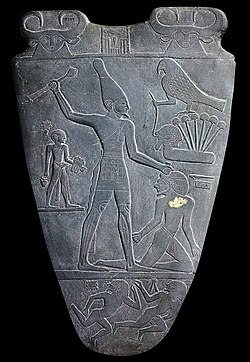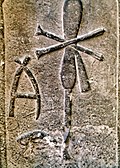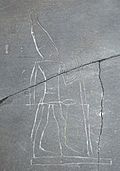First Dynasty of Egypt | |||||||||||
|---|---|---|---|---|---|---|---|---|---|---|---|
| c. 3100 BC–c. 2900 BC | |||||||||||
 Narmer Palette (c. 3200–3000 BC) | |||||||||||
| Capital | Thinis | ||||||||||
| Common languages | Egyptian language | ||||||||||
| Religion | Ancient Egyptian religion | ||||||||||
| Government | Absolute monarchy | ||||||||||
| Historical era | Bronze Age | ||||||||||
• Established | c. 3100 BC | ||||||||||
• Disestablished | c. 2900 BC | ||||||||||
| |||||||||||
| Periods and dynasties of ancient Egypt |
|---|
All years are BC and AD |
The First Dynasty of ancient Egypt (Dynasty I) [1] covers the first series of Egyptian kings to rule over a unified Egypt. It immediately follows the unification of Upper and Lower Egypt, by Menes, or Narmer, [2] and marks the beginning of the Early Dynastic Period, when power was centered at Thinis.
Contents
- The dynasty
- Conflicts
- Human sacrifice
- Rulers
- Comparison of regnal lists
- See also
- References
- Citations
- Bibliography
The date of this period is subject to scholarly debate about the Egyptian chronology. It falls within the early Bronze Age and is variously estimated to have begun anywhere between the 34th and the 30th centuries BC. In a 2013 study based on radiocarbon dates, the accession of Hor-Aha, the second king of the First Dynasty, was placed between 3111 and 3045 BC with 68% confidence, and between 3218 and 3035 with 95% confidence. [3] The same study placed the accession of Den, the sixth king of the dynasty, between 2928 and 2911 BC with 68% confidence, [3] although a 2023 radiocarbon analysis placed Den's accession potentially earlier, between 3011 and 2921, within a broader window of 3104 to 2913. [4]




















